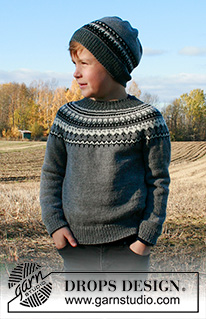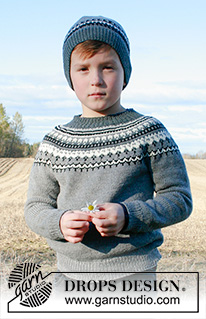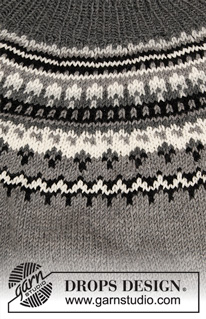Dalvik |
||||||||||||||||||||||
 |
 |
|||||||||||||||||||||
Knitted jumper for children in DROPS BabyMerino. The piece is worked top down with round yoke and Nordic pattern. Sizes 2-12 years. Knitted hat for children in DROPS BabyMerino with Nordic pattern.
DROPS Children 34-18 |
||||||||||||||||||||||
|
------------------------------------------------------- EXPLANATIONS FOR THE PATTERN: ------------------------------------------------------- INCREASE/DECREASE TIP (evenly spaced): To work out how to increase/decrease evenly, count the total number of stitches on needle (e.g. 88 stitches) and divide by the number of increases/decreases to be made (e.g. 27) = 3.2. In this example, increase by making 1 yarn over after approx. each 3rd stitch. On the next row knit the yarn overs twisted to avoid holes. When decreasing, knit together approx. each 2nd and 3rd stitch. ELEVATION (back of neck): To make the jumper slightly higher at the back of the neck when working the yoke, work an elevation as described here. Skip this section if you do not want an elevation. Start from the right side, mid back and work with dark grey as follows: Knit 15-15-16-16-17-17 stitches, turn, tighten strand and purl 30-30-32-32-34-34 stitches back. Turn, tighten strand and knit 45-45-48-48-51-51 stitches, turn, tighten strand and purl 60-60-64-64-68-68 stitches back. Turn, tighten strand and knit 75-75-80-80-85-85 stitches, turn, tighten strand and purl 90-90-96-96-102-102 stitches, turn and knit to mid back. Then work YOKE as described in the text. PATTERN: Jumper: See diagrams A.1 and A.2. Choose diagram for your size (A.2 applies only to sizes 2 years – this repeat is worked on the yoke in the other sizes). Hat: See diagram A.3. The whole pattern is worked in stocking stitch. DECREASE TIP (for mid under sleeves): Decrease 1 stitch on each side of the marker thread as follows: Work until there are 3 stitches left before the marker thread, slip 1 stitch as if to knit, knit 1 and pass the slipped stitch over the knitted stitch, knit 2 (marker thread sits between these 2 stitches), knit 2 together (= 2 stitches decreased). CASTING-OFF TIP: To avoid the cast-off edge being tight you can cast off with a larger needle size; or you can make 1 yarn over after approx. each 8th stitch at the same time as casting off (yarn overs cast off as normal stitches). ------------------------------------------------------- START THE PIECE HERE: ------------------------------------------------------- JUMPER - SHORT OVERVIEW OF THE PIECE: Neck and yoke are worked in the round with circular needle, top down. The yoke is divided for body and sleeves and the body is continued in the round with circular needle. Sleeves are worked in the round with double pointed needles, top down. NECK: Cast on 88-90-92-94-96-98 stitches with short circular needle size 2.5 mm and dark grey. Knit 1 round and then work rib in the round (= knit 1 / purl 1) for 3 cm. Knit 1 round where you increase 27-30-33-31-34-37 stitches evenly spaced – read INCREASE/DECREASE TIP = 115-120-125-125-130-135 stitches. Knit 1 round. Insert 1 marker at the beginning of the round = mid back. Now you can work an ELEVATION in the back of the neck – read description above. If you do not want an elevation, go straight to yoke. YOKE: Change to circular needle size 3 mm and work A.1 in the round (= 23-24-25-25-26-27 repeats of 5 stitches). Continue this pattern and increase as shown in the diagram. REMEMBER THE KNITTING TENSION! On the round before the one marked with an arrow in A.1, there are 230-240-250-250-260-270 stitches on the needle. On the round marked with an arrow in A.1, increase 10-20-22-30-36-38 stitches evenly spaced = 240-260-272-280-296-308 stitches. When A.1 has been completed the piece measures approx. 14-16-16-16-16-16 cm from the cast-on edge mid front. Continue in the round with stocking stitch and grey until the piece measures 14-16-16-17-18-19 cm from the cast-on edge mid front. Now, on the next round, divide the yoke for body and sleeves as follows: Work 35-38-40-42-44-46 stitches in stocking stitch with grey (= ½ back piece), place the next 50-54-56-56-60-62 stitches on 1 thread for sleeve, cast on 6-6-6-8-8-8 new stitches on the needle (= in side under sleeve), work 70-76-80-84-88-92 stitches in stocking stitch with grey (= front piece), place the next 50-54-56-56-60-62 stitches on 1 thread for sleeve, cast on 6-6-6-8-8-8 new stitches on the needle (= in side under sleeve) and work the remaining 35-38-40-42-44-46 stitches in stocking stitch with grey (= ½ back piece). Cut the strand. Body and sleeves are continued separately. THE PIECE IS NOW MEASURED FROM HERE! BODY: = 152-164-172-184-192-200 stitches. Insert 1 marker in the middle of the 6-6-6-8-8-8 stitches under the one sleeve. Start the round at this marker and work A.2 in the round (applies only to sizes 2 years– this repeat was worked on the yoke in the other sizes). When A.2 has been completed continue with stocking stitch and grey (all sizes). Work with grey until the piece measures 15-17-21-24-27-30 cm from the division (or to desired length; there is approx. 5 cm left to finished length). Change to circular needle size 2.5 mm and work rib in the round (= knit 1/ purl 1) for 5 cm. Loosely cast off with knit over knit and purl over purl – read CASTING-OFF TIP! The jumper measures approx. 36-40-44-48-52-56 cm from the shoulder down. SLEEVE: Place the 50-54-56-56-60-62 stitches from the thread on the one side of the piece on double pointed needles size 3 mm and knit up 1 stitch in each of the 6-6-6-8-8-8 stitches cast on under sleeve = 56-60-62-64-68-70 stitches. Insert 1 marker thread in the middle of the 6-6-6-8-8-8 stitches under the sleeve; allow it to follow your work onwards - it will be used when decreasing mid under sleeve. Start the round at the marker thread and work A.2 in the round (applies only to sizes 2 years – this repeat was worked on the yoke in the other sizes). When A.2 has been completed continue with stocking stitch and grey (all sizes). AT THE SAME TIME when the piece measures 2 cm from the division, decrease 2 stitches mid under sleeve – read DECREASE TIP. Decrease like this every 3-3-3½-4-4-4½ cm a total of 6-7-7-7-8-8 times = 44-46-48-50-52-54 stitches. Continue with grey until the piece measures 18-21-26-29-33-37 cm from the division (or to desired length; there is approx. 5 cm left to finished length). Change to double pointed needles size 2.5 mm and work rib in the round (knit 1/ purl 1) for 5 cm. Loosely cast off with knit over knit and purl over purl – read CASTING-OFF TIP! The sleeve measures approx. 23-26-31-34-38-42 cm from the division. Work the other sleeve in the same way. ------------------------------------------------------- HAT - SHORT OVERVIEW OF THE PIECE: The piece is worked in the round with short circular needle, bottom up. Change to double pointed needles when necessary. HAT: Cast on 138-144-150 stitches with short circular needle size 2.5 mm and dark grey. Work rib in the round (= knit 1/ purl 1) for 4 cm. Knit 1 round where you decrease 26-28-30 stitches evenly spaced – read INCREASE/DECREASE TIP = 112-116-120 stitches. Change to short circular needle size 3 mm and work A.3 in the round (= 28-29-30 repeats of 4 stitches). REMEMBER THE KNITTING TENSION! On the round marked with an arrow in A.3 decrease 1-2-0 stitches evenly spaced = 111-114-120 stitches. Continue the pattern (there is now room for 37-38-40 repeats of 3 stitches). When A.3 has been completed the piece measures approx. 11 cm from the cast-on edge. Continue with stocking stitch and grey. When the piece measures 13-15-17 cm from the cast-on edge, knit 1 round where you decrease 1-4-0 stitches evenly spaced = 110-110-120 stitches. Now insert 10 markers in the piece with 11-11-12 stitches between each one. On the next round decrease 1 stitch after each marker by knitting 2 stitches together (= 10 stitches decreased). Decrease like this every 2nd round a total of 9 times in all sizes (change to double pointed needles when necessary) = 20-20-30 stitches left. On the next round knit all stitches together 2 and 2 = 10-10-15 stitches left. Work 1 more round where all stitches are knitted together 2 and 2 = 5-5-8 stitches left. Cut the strand, pull it through the remaining stitches, tighten and fasten well. The hat measures approx. 19-21-23 cm from the top down. |
||||||||||||||||||||||
Diagram explanations |
||||||||||||||||||||||
|
||||||||||||||||||||||

|
||||||||||||||||||||||

|
||||||||||||||||||||||
|
Have you made this or any other of our designs? Tag your pictures in social media with #dropsdesign so we can see them! Do you need help with this pattern?You'll find tutorial videos, a Comments/Questions area and more by visiting the pattern on garnstudio.com. © 1982-2024 DROPS Design A/S. We reserve all rights. This document, including all its sub-sections, has copyrights. Read more about what you can do with our patterns at the bottom of each pattern on our site. |
||||||||||||||||||||||












































































Comments / Questions (34)
Bonjour, Je fais la taille 2 ans, pour séparer les manches et dos/devant c’est 14 cm du début ou après les cotes ? Merci beaucoup
27.03.2020 - 08:29DROPS Design answered:
Bonjour Nadia! Cela doit etre depuis le rang de montage le long du devant , avec les cotes. Bon tricot!
27.03.2020 - 09:33Dalvik mönster storlek 2 år. Förstår inte diagrammet A2. Vad är det som skiljer det från A1? Jag har repat upp när jag upptäckte jag hade stickat A1 hela vägen upp. Vad gör jag nu? Vänligen Cim
18.02.2020 - 22:44DROPS Design answered:
Hej I den minsta storleken stickar du A.2 efter att du delat oket till fram & bakstycke och ärmar (i de större storlekarna stickar du den delen på oket eftersom den då tillhör A.1) detta pga att oket är kortare i den minsta storleken. Om du läser i början av stycket FRAM- OCH BAKSTYCKE så ser du att du där stickar A.2. Lycka till!
19.02.2020 - 07:36Hei,\r\nKysisin mitä käytännössä tarkoittaa \"luo apulangan silmukoiden tilalle 6-6-6-8-8-8 silmukkaa (= sivussa hihan alla)\". Onko tähän olemassa ohjevideota?
14.02.2020 - 09:12Hallo liebes Team, ich möchte den Pullover ohne Muster in Dunkelblau stricken. Nur bei der Passe denke ich an 1 Knäuel Hellblau für Streifen.Wieviel Material brauche ich dann in Dunkelblau für Größe 11/12?Danke und ein schönes Weihnachtsfest!Ingrid
18.12.2019 - 07:52DROPS Design answered:
Liebe Frau Markovsky, leider können wir jeder Anleitung nach jedem individuellen Frage anpassen und einzelne Modelle auf individuellen Wunsch hin umrechnen. Wenn sie Hilfe damit brauchen, wenden Sie sich bitte an dem Laden wo Sie die Wolle gekauft haben, dort hilft man Ihnen gerne weiter. Viel Spaß beim stricken!
18.12.2019 - 07:54Er lidt i tvivl om dette under ærmer: Sæt de 50-54-56-56-60-62 masker fra tråden i den ene side af arbejdet tilbage på strømpepinde 3, og strik 1 ny maske i hver af de 6-6-6-8-8-8 masker som blev slået op under ærmet = 56-60-62-64-68-70 masker. De 6 masker der er blevet slået op strikkes jo med på for og bagstykke. Skal jeg strikke nye masker op i dem, der allerede er strikkede?
10.12.2019 - 10:02DROPS Design answered:
Hei Kristina! Det skal plukkes opp masker fra kanten der 6-6-6-8-8-8 masker ble lagt opp under ermet, det er mulig å se hvordan det gjøres her . Lykke til!
10.12.2019 - 10:15Hei. Jeg ser at det opereres med to ganger lys grå i diagrammet. Er det meningen at det skal være to ulike grpnyanser, eller er det en feil? Mvh Britt
23.10.2019 - 16:16DROPS Design answered:
Hej. Tack för info, det var ett fel som nu är rättat! Mvh DROPS Design
24.10.2019 - 06:42Merci DROPS pour la réponse rapide! Je m'en doutais mais préférais que la correction soit effective pour tous.
25.09.2019 - 12:18Le 20 juillet, Ben vous a demandé si la rehausse était correcte et il vous a donné une solution; vous n'y avez pas répondu à ma connaissance. J'en suis au même point de reflexion et j'abonde dans son sens! merci de signifier l'erreur et attend pour continuer. Car le modèle est superbe..
24.09.2019 - 19:08DROPS Design answered:
Bonjour Bibi, nos stylistes vont vérifier la réhausse pour qu'il y ait le même nombre de rangs de chaque côté du milieu dos. Edit 11:27: la correction a été faite, vous la retrouverez dans les explications et en rouge sous "corrections". Bon tricot!
25.09.2019 - 07:56Hi DROPS, Thanks for this great pattern. Just a comment regarding the elevation - I think the instructions result in an asymmetrical elevation. After the 75 knit stitches there needs to be 90 purl stiches, then turn and knit 45 stitches - which will return the working yarn to the mid back. Is this correct?
20.08.2019 - 00:21Hvor er diagrammet til denne genseren? Jeg strikker den og plutselig er diagrammet borte???
22.07.2019 - 10:57DROPS Design answered:
Hei Birgit, Diagrammene er på bunnen av oppskriften. God fornøyelse!
23.07.2019 - 07:38